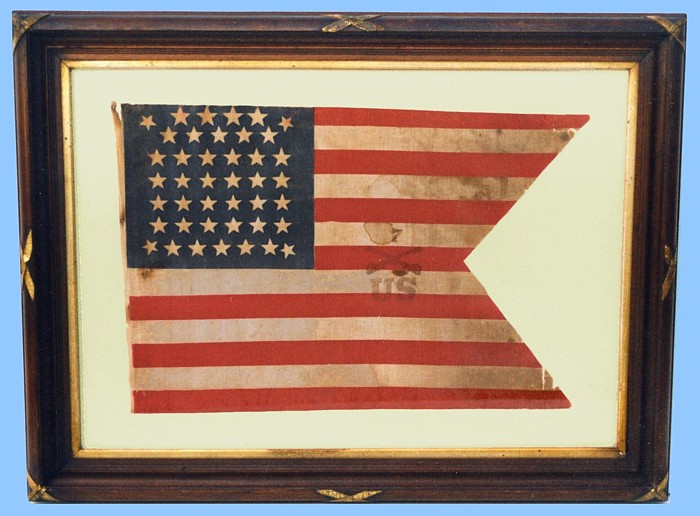
| |
42 STARS, GUIDON FORM, BEEHIVE CONFIGURATION, 7TH CAVALRY OVERPRINT |
|
| Available: |
Sold |
| Frame Size (H x L): |
approx. 29.5" x 39" |
| Flag Size (H x L): |
19.5" x 29" |
|
| Description....: |
|
| 42 STARS, GUIDON FORM, BEEHIVE CONFIGURATION, 7TH CAVALRY OVERPRINT:
42 star American national parade flag, printed on cotton. Bears an overprint with markings of the 7th U.S. Cavalry, which is the regiment made famous by General George Armstrong Custer. This is one of a group of parade flag guidons used in ceremonies at Ft. Sheridan, Illinois, sometime between November, 1889 and July, 1890. In fact, this flag is, without doubt, the most unique and interesting of any of those used at this event that is currently known to exist. The participants were soldiers of the Indian Wars, which were still in progress. Although Custer was not alive at the time, all 19th century artifacts belonging to the 7th Cavalry are extremely rare and highly desired.
Adding to the historical context of this flag are folk qualities that surpass most all parade flags. The swallowtail design is most readily apparent, but the beehive star configuration is even more fantastic. I have seen this design on only 3 other occasions. None of those three flags had the 7th Cavalry overprint, and one of them was completely destroyed and behind salvaging. The pattern consists of 7 rows of stars, all pointing upward, that form a basic beehive shape. There are 4 additional smaller stars in each corner, each tilted at 45 degrees. The bottom 2 may be helping to form the base of the hive, or all 4 may more likely represent worker bees. Note also that the top 4 stars on the hive are larger than all the rest. In each case, the number 4 most certainly relates to the 4 states that had just joined the Union in a 10 day period, from Nov. 2nd-11th, 1889 (North & South Dakota, Montana, and Washington). The beehive is not such an unusual element to incorporate in a flag design, because it is a universal icon for hard work and industry. This was at the very forefront of American politics during this time period, when rapid improvements were made in the manufacturing sector and railroads stretched ever further throughout the Louisiana purchase. It was not the first use of a beehive in American flags, either, as several revolutionary period flags exist that contain its representation.
This flag was acquired through the commandant of the decommissioned fort. It is made of printed cotton, and the forking of the striped area of the flag is different from standard parade flags. It is reasonable to believe that this was done by the soldiers, who carried this type of swallowtail flag due to its better wind flow while riding in the windy frontier wilderness. Parade flags were printed on large bolts like most textiles, and clipped from the roll typically at the time of the sale (for example, when sold at a general store). It seems evident that the supplies officer at Ft. Sheridan had them overprinted with the regiment insignias. |
|
|
|
| Collector Level: |
|
|
| Flag Type: |
Parade flag |
|
| Star Count: |
42 |
|
| Earliest Date of Origin: |
1889 |
|
| Latest Date of Origin: |
1890 |
|
| State/Affiliation: |
Washington |
|
| War Association: |
1866-1889 Indian Wars |
|
| Price: |
No |
|
| |
Views: 4284 |
|
|
|

